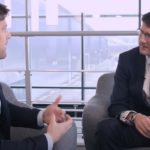“Huge” opportunities will emerge in the aftermath of the pandemic, but the industry will have to learn to become more “risk averse,” according to Ajan Meijer, President and CEO of Embraer Commercial Aviation.
Meijer said that, in the short term, getting out of the crisis and supply chain issues would be the biggest challenges which lay ahead for the aviation industry. He added: “I think the opportunities that Embraer sees ahead of this are huge. Typically, post-crisis, we see an increased demand for smaller segments. The crisis has terribly hit our customers and I think, as an industry, we need to be more risk-averse going forward on one side, and we also need to be more sustainably aware about the future. Challenges bring new opportunities and I think Embraer is in great position and looks forward to a great future.”
Meijer said Embraer would benefit from a keener focus on risk management and the return to profitability. He explained: “[Challenges and opportunity], well, they typically come hand in hand so I think certainly in the Embraer world, in the segment below 150 seats, we see that if there’s a lot of challenges in the industry, that customers are looking at better ways to manage risk into the future to get back to profitability.”
“What really helps, there is smaller aircraft that offer lower trip costs, so you don’t have to spend the money on more expensive airplanes on your trip, but the seat cost on those seats that you can offer to the customer are still very attractive.”
Market Outlook revised down for 2040
Meijer caught up with FINN on the E2, which he described as “the most efficient and most cost-efficient aircraft in the single aisle market today. He added that the offer to airlines was an aircraft with a capacity that was “very attractive from a profit perspective.”
With passenger numbers still recovering from more than two years or lockdowns and restrictions, Meijer said that Embraer’s Market Outlook had revised its global outlook for the 2040 market to be roughly 20 per cent smaller its previous forecasts which were published a few years ago.
“That’s all caused by two things,” he explained. “One, of course, the dramatic impact of Covid, and going forward, a slightly lower growth than we anticipated before, that will lead obviously to a less number of aircraft being required for the industry or a less number of seats. We believe that the airlines will focus more on the lower segment to fill that gap, so I think from an Embraer perspective, the unlimited growth into bigger and bigger aircraft with more and more seats, we believe that’s a trend that will change going forward.”
Reducing fuel burn and emissions during the pandemic
He said Embraer had stayed busy during the Covid pandemic with many engineering hours spent exploring how the OEM could play “a different role going forward.”
He explained “Embraer spent a lot of time on looking at the capability of flying SAF on our aircraft to begin with. We launched E2 rather early in the E1 programme because we saw we could deliver a 15 plus per cent fuel burn to the market by improving our E1 into a new platform and, in the end, lower fuel burn results in less CO2 and that CO2 that we don’t have to replace with alternate fuels or offsets. Getting aircraft out there with the best environmental footprint is something that Embraer has done for many, many years now and that’s what we’ll keep doing, going forward.”
Meijer said the company was looking to launch a new TP next year which was expected to come to market in 2027, which would deliver a reduced CO2 footprint, together with a better on-board product and a lower noise experience.
The company has also been working on its Energia concept aircraft as the industry moves towards net zero.
Meijer explained: “It’s still concepts, but it is the area between 1 and 50 seats that we are looking at. What technologies we can bring to the market that are either reducing the CO2 significantly or reducing entirely to zero in combination with sustainable fuels in some cases. Then, going forward, we hope to roll those technologies forward to the turboprop and the E2 in the future. There’s a strategic plan that we see ahead of us and we’re going to work with customers and partners to see how we can deliver and convert those concepts to real products in the next couple of years.”

